One thing DC has always been known for are their supervillains. They have iconic villains such as Joker and Catwoman, who have both had their own feature films. The thing about that is, for every Joker, there are ten Mr. Cameras. DC may have some of the most iconic villains, but they also have a significant amount of obscure, odd, and terrible villains. Right now we will be going over a few of those ones from the Golden Age of Comics.
“What is the Golden Age of Comics”, you may ask? Well, it is a period from 1938 until 1949 in which there was a significant boom in superhero comics, and we were introduced to many iconic characters such as Superman, Batman, Wonder Woman, Flash, Green Lantern, Joker, and many others. It started with the release of Action Comics #1 and ended with the mass cancelation of many superhero features, such as the Justice Society, Green Lantern, Flash, and many others. It is known for its focus on the pulp roots of comics and consisted of mostly superhero anthology books.
Thorn
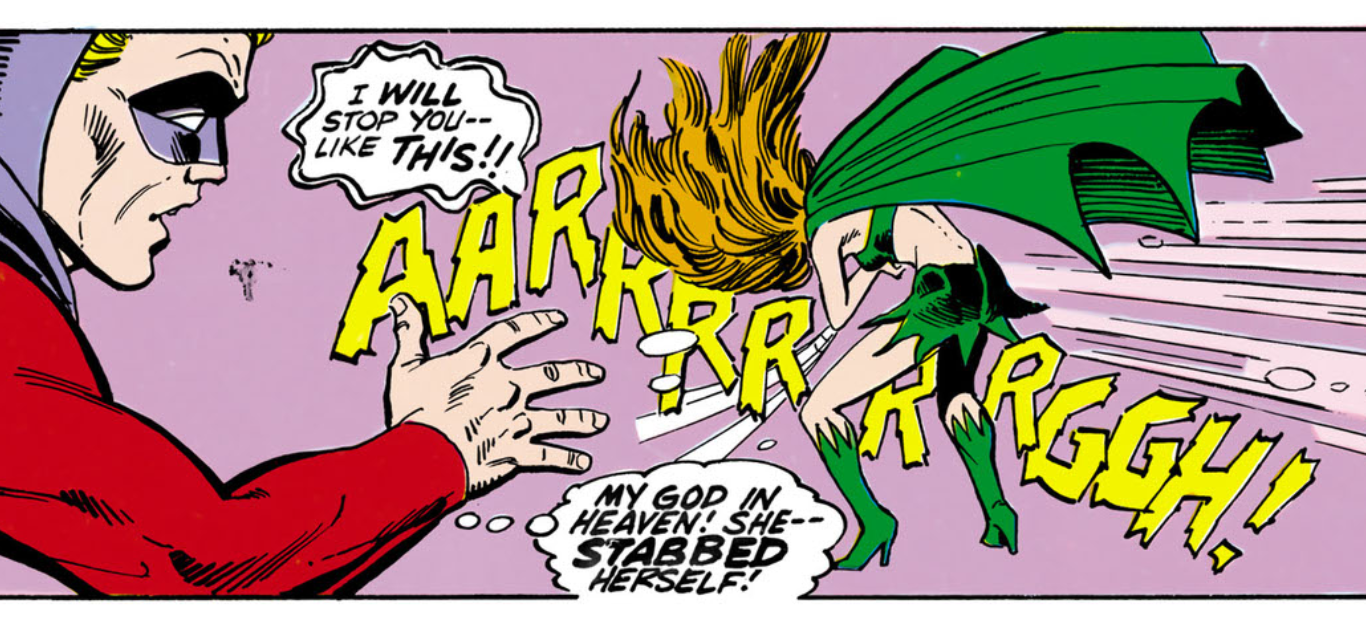
This villain was one by the name of Rose Canton, who has a Jeckle and Hyde type personality as Rose and Thorn, with Thorn being the villainous alter-ego. Rose Canton was originally an enemy of the first Flash, Jay Garrick, and she hired thugs to oppose The Flash. Thorn had the ability to control plants. After Thorn was captured, she was taken to Paradise Island and reformed, as Paradise Island, at the time, was used as a reformation prison for female villains, and this trope was prominently featured in the Wonder Woman comics at the time. During her time on Paradise Island, she developed a crush on Alan Scott. She changed her identity, wooed him, and married him.
Tragedy struck on their honeymoon when Thorn returned. Rose fled from Alan in fear of hurting him, secretly had his two children, Jade and Obsidian, and immediately gave them up for adoption. Scott was unaware that Thorn was actually his wife, so he continued to fight her, and eventually, his two children did as well. Eventually, Rose wrestled back control and killed herself to prevent Thorn from coming back.
Harlequin
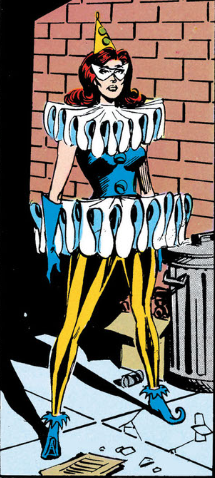
Jerry Ordway, Mike Machlan, Tony DeZuniga
Alan Scott really has a problem with his love life. After he believed Rose died, Alan Scott married Harlequin, another one of his arch-villains. Harlequin, in reality, is Molly Mayne, was someone who developed a crush on Green Lantern, so she dressed up in a colorful costume and committed mostly harmless crimes in order to attract his attention. Alan Scott also was attracted to Harlequin, but never pursued a relationship with her. After about 30 years, after the death of Rose Canton, Alan Scott’s wife, Alan realized he loved Harlequin the entire time. He married her, but Starheart prevented Alan from aging, meaning Alan was still young while Harlequin aged, so she made a deal with the demon Neron in order to reverse her aging. Neron stole her soul, so Alan Scott and recent Green Lantern Kyle Rayner had to fight their way through Hell in order to get Molly’s soul back.
Crazy Quilt
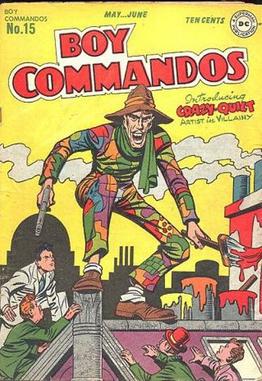
What would you say if I told you that this utterly terrible villain was created by the most legendary comic creator ever? You would think I was insane! Well, I’m not. Back in 1946, the King of Comics himself Jack Kirby created Crazy Quilt as a villain for the Boy Commandos, which was a group of children who would fight criminals and Nazis. Captain America creators Joe Simon and Jack Kirby created the group when they were poached from Timely Comics (which would later be known as Marvel) and were told they could create anything. They decided to create a group of fighting kids after seeing the success of sidekicks like Robin, and their own creation, Bucky.
Crazy Quilt was originally a painter who would give instructions to his henchmen by putting clues in his paintings. His empire fell when one of his henchmen betrayed him, and he was blinded. He participated in an experimental procedure, but that left him only being able to see bright colors. He creates a helmet that emits brightly colored lights, which enables him to see most of what is around him. (Side note- DC editorial really liked having brightly colored villains beat Jason Todd. In a Post-Crisis appearance, Crazy Quilt beat Jason Todd within an inch of his life. This was before Joker famously beat Jason Todd with a crowbar.)
Two-Face
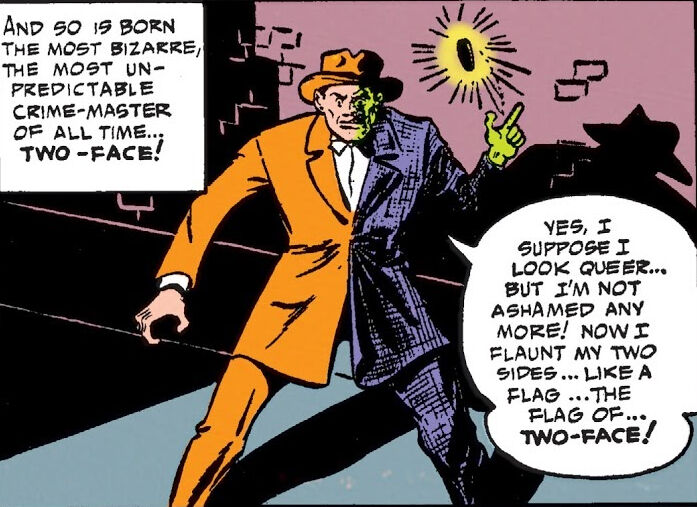
Yes, I know Harvey Dent is an extremely famous character. But this is not Harvey Dent. I am talking about the multiple other Two-Faces that have existed within DC Comics over the years. An entire page could be dedicated to the multitude of other Two-Faces, especially the Golden Age ones. There were: Harvey Kent, Wilkins, Paul Sloane, and George Blake as Two-Face in a matter of a few years.
*It is highly debated whether or not Bob Kane worked on the stories he is credited to. Most, if not all, of his work was allegedly done by ghost artists he hired, by Dick Sprang, Jerry Robinson, or Sheldon Moldoff.
Harvey Kent

Harvey Kent was the first Two-Face and is the one closest to what we see as Two-Face nowadays. He was a prosecuting attorney whose face was scarred by acid. The major difference between him and the current version of Two-Face is that Harvey Kent never relapsed back into being Two-Face after his face was fixed and he was cured.
Wilkins

Credit: “Bob Kane*”, Lew Sayre Schwartz,
Charles Paris
The next Two-Face was Harvey Kent’s butler, who used makeup in order to disguise himself as Two-Face in order to drive suspicion on Kent instead of himself. Kent believed he was turning into Two-Face without his knowledge and attempted leaving in order to stop Two-Face from committing more crimes. Batman and Robin figured out this new Two-Face’s identity when they found Harvey Kent tied up and drugged. They captured the new Two-Face and unmasked him as Kent’s butler Wilkins.
Paul Sloane
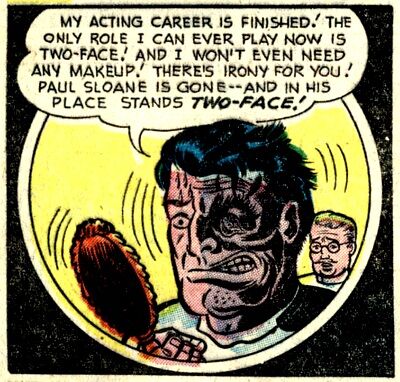
Bob Kane*, Lew Sayre Schwartz, Charles Paris
The third Two-Face within the Golden Age was actor Paul Sloane. He was hired to play Two-Face in a biographical movie about Two-Face, but he was disfigured in an accident that scarred his face similar to the first Two-Face. This was because a prop man substituted the fake acid used in the trial scene with real acid instead because the prop man’s girlfriend had a crush on Sloane. Sloane realizes that it would be much more profitable if he turned to crime instead of acting, so he took a prop coin and turned it into Two-Face’s coin. Batman then tricked Sloane into getting reconstructive surgery, which cured his mental state.
George Blake

The fourth and final Two-Face in the Golden Age was George Blake, who impersonated Two-Face at a museam exhibition Harvey Kent was attending, who was dressed as Two-Face because of the subject of the new exhibition. Batman figured out who the new Two-Face was because Goerge Blake put on the Two-Face makeup on the wrong side.

